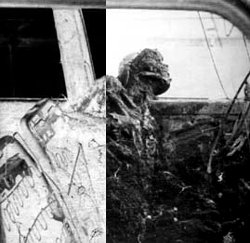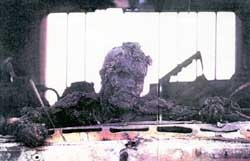|
..:: War-time Casualties Before the war, defense analysts described the Iraqi military as "poorly trained, poorly equipped and demoralized." While Iraqi troops fought with unexpected vigor, US military superiority and its reliance on overwhelming air power killed large numbers of Iraqi soldiers. The bombing campaign left thousands of soldiers dead, perhaps tens of thousands. Maj. Gen. J. D. Thurman, the chief operations officer for the land war command, said, "We are going to prosecute this fight in a violent manner," to show Iraqis that Saddam's forces are no longer in charge. Gen. Norman Schwarzkopf estimated Iraqi losses during the first Gulf War as being in the "tens of thousands." While the military emphasized the use of smart bombs to the media, more than 90% of the bombs dropped on Iraq were not smart bombs, and could be led astray by the winds. The Tomahawk cruise missiles also had limited success, with most Tomahawks wandering off course. The Iraqi military was crushed by carpet bombing by B-52 bombers. In the first Gulf War, the US also used weapons of mass destruction prohibited by international law. Fuel air explosives were used against troops in place, civilian areas, oil fields and fleeing civilians and soldiers on two stretches of highway between Kuwait and Iraq. Napalm was used against civilians and military personnel, as well as to start fires. Oil well fires in both Iraq and Kuwait were intentionally started by US aircraft dropping napalm and other heat intensive devices. Cluster bombs and anti-personnel fragmentation bombs were used in Basra, and other cities and towns, against the civilian convoys of fleeing vehicles and against military units. Cluster bombs are being used again in Iraq. Some of these methods of waging war have been rejected by allies. At least five British officers resigned their commissions during the first Gulf War when they saw the effects of US used cluster bombs and fuel-air explosives on Iraqi soldiers. In Afghanistan, Canadian soldiers were ordered by their American commander to lay mines and refused to do so. During the Gulf War, there was a serious problem of the use of excessive force that go beyond war aims, against both Iraqi civilians and soldiers. Gen. Barry McCaffrey orchestrated a massacre of hundreds of Iraqi troops, two days after a cease-fire went into effect at the end of the Gulf War. According to the Greenpeace report, "One Army analyst familiar with the situation reports submitted by units involved in the attacks on retreating troops estimates that as many as 25,000 Iraqis were killed on the 'highway to hell,' and in other retreating convoys from al Jahra to Iraq." There are also incidents of US soldiers firing on Iraqi prisoners of war. Former US Army Specialist John Brasfield recorded soldiers on tape saying fellow Americans had shot unarmed Iraqi prisoners. |
LIES | THRIVES | ACT | CONTACT
The Progress of War : Pentagon Defends Use of Civilian Clothes, Newsday : US forces Occupy Schools and Church, CSM : Coalition Troops Encircle Baghdad, CNN : Tikrit Blitzed to Forestall Last Stand, Guardian : US Troops' Anguish: Killing Outmatched Foes, CSM : US Troops Face Children in Battle, Reuters : Number of Iraqi Dead May Be Unknowable, NYT The Results of the First Gulf War : The Gulf War: Not so Clean, The Bulletin of Atomic Scientists : US War Crimes during the Gulf War by Francis Boyle : The Unseen Gulf War, photographs by Peter Turnley : This Is War, photos from The Memory Hole
|




